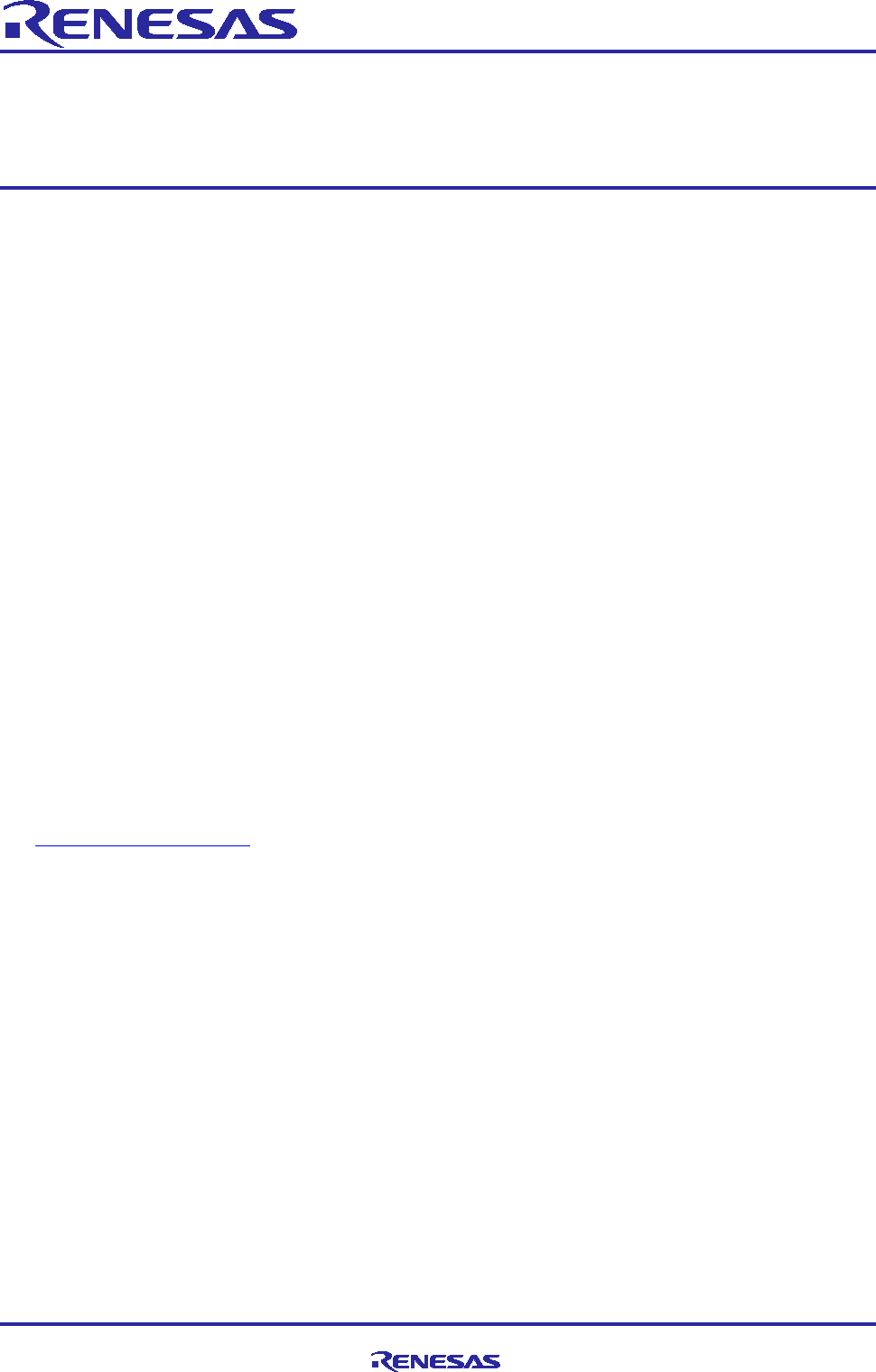
Application Note
R30AN0248EU0103 Rev.1.03 Page 1 of 15
May.17.19
Renesas Synergy™ Platform
Getting Started with the Audio Player Application using
SSP
Introduction
This application note describes the Audio Player demonstration application for Synergy S7G2 MCU based
Kits. Audio Player is a Human Machine Interface (HMI) application that uses Synergy Software Package
(SSP) with GUIX™, USBX™, and FileX
®
. The program consists of a simple file browser with audio playback
capabilities. The interface employs several GUIX widgets and touch controls to manage the underlying Audio
Playback Framework and Mass Storage Controller (MSC).
Audio Player is based on SSP and uses Express Logic, Inc. ThreadX
®
Real-Time Operating System (RTOS),
GUIX, USB, and FileX through the e
2
studio Integrated Solutions Development Environment (ISDE) or IAR
Embedded Workbench
®
for Renesas Synergy™. The application code and configuration may be referenced
for event-driven HMI and MSC systems. The program includes code based on GUIX and the SSP for fast
graphics rendering and display, and uses the graphics accelerators available on the S7G2 devices. It also
implements USBX and FileX to allow it to access data on FAT-formatted USB Mass Storage Devices.
Required Resources
• Any of the following Kits
Renesas Synergy SK-S7G2 Starter Kit (Currently supported)
Renesas Synergy DK-S7G2 Development Kit
Renesas Synergy PE-HMI1 Product Example for HMI applications
Renesas Synergy PK-S5D9 Promotional Kit
• e
2
studio ISDE v7.3.0or later
• Synergy Software Package (SSP) 1.6.0 or later
• IAR EW for Synergy 8.23.3 or later
• SSC v7.3.0 or later
• Segger J-link
®
USB driver
• Micro USB cables
• USB 2.0 Flash drive
• Download all the required Renesas software from the Renesas Synergy™ Gallery
(www.renesas.com/synergy
).
Supported File Formats
Audio Player application is compatible with uncompressed WAVE files in PCM format. Please make sure the
audio stream is signed mono, with 16 bits per sample and sampling frequency of 44.1-kHz. The Audio Player
prevents incompatible files from playing and produce a warning message (visible on a status bar).

Renesas Synergy™ Platform Getting Started with the Audio Player Application using SSP
R30AN0248EU0103 Rev.1.03 Page 2 of 15
May.17.19
Contents
1. Supported Boards and Files .................................................................................................... 3
2. Running the Audio Player Application ...................................................................................... 3
2.1 Connecting to the Board and Importing the Project into e
2
studio .......................................................... 3
2.2 Running and Verifying the Application .................................................................................................... 3
2.3 Limitations ............................................................................................................................................... 3
3. Application Features ................................................................................................................ 4
3.1 Splash Screen ......................................................................................................................................... 4
3.2 USB Screen ............................................................................................................................................. 4
3.3 Main Screen ............................................................................................................................................ 5
3.3.1 Overview ................................................................................................................................................ 5
3.3.2 Playback Controls ................................................................................................................................. 6
3.4 Compatible Audio Formats ...................................................................................................................... 7
4. Application Design ................................................................................................................... 8
4.1 Source Code Layout ................................................................................................................................ 8
4.2 Thread Layout ......................................................................................................................................... 8
4.2.1 Module Hierarchy .................................................................................................................................. 8
4.2.2 Thread Modules and Objects ................................................................................................................ 9
4.3 Thread Initialization ................................................................................................................................. 9
4.4 Thread Resources ................................................................................................................................. 10
4.4.1 Static Variables.................................................................................................................................... 10
4.4.2 Global Variables .................................................................................................................................. 10
4.5 Inter-thread Communication .................................................................................................................. 10
4.5.1 Command Messages .......................................................................................................................... 11
4.5.2 Callback Messages ............................................................................................................................. 11
4.6 Message Process Flow Example .......................................................................................................... 12
4.7 Audio Thread Processing Flow ............................................................................................................. 12
4.8 GUI Structure ......................................................................................................................................... 13
Revision History ............................................................................................................................ 15
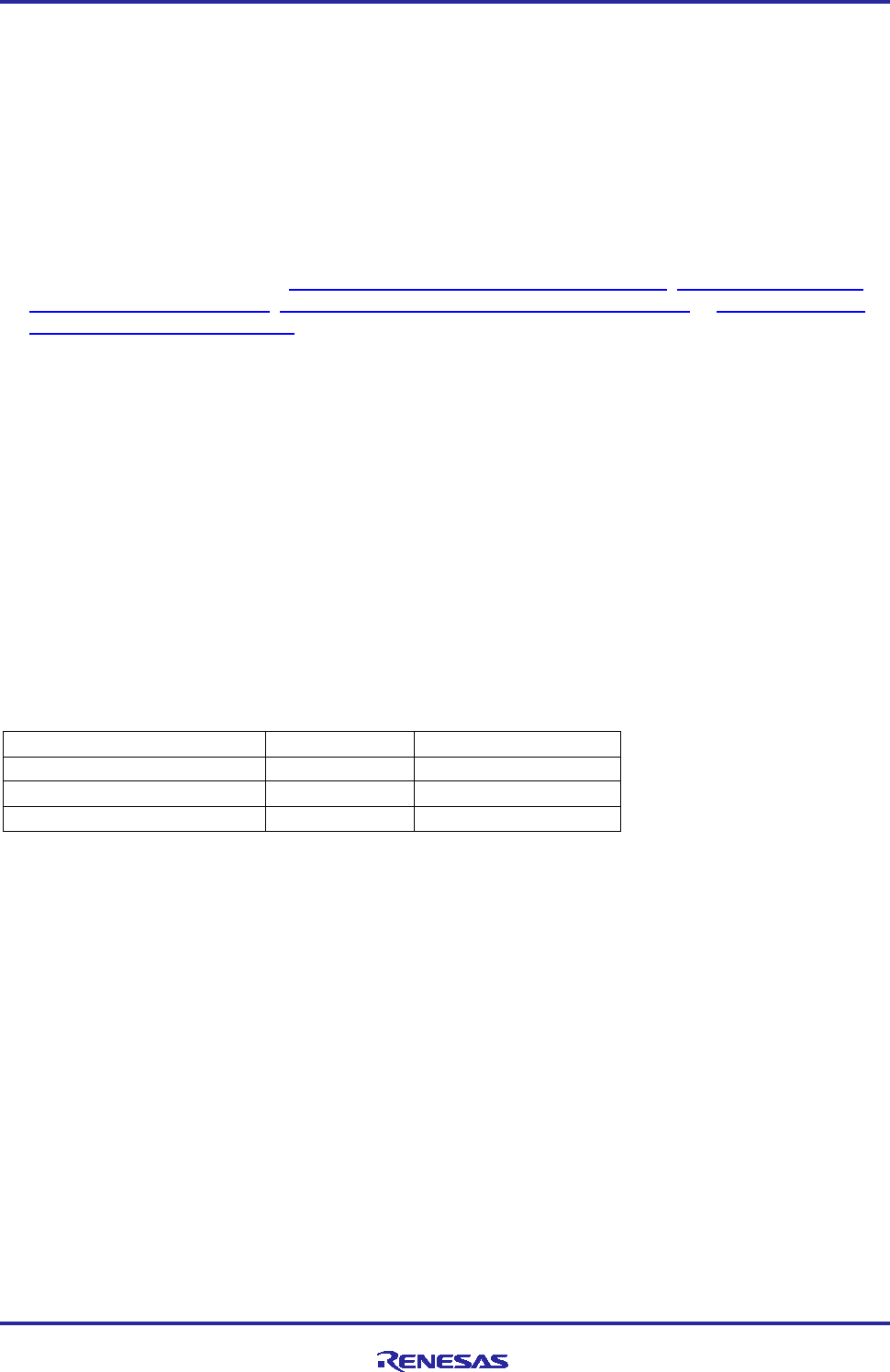
Renesas Synergy™ Platform Getting Started with the Audio Player Application using SSP
R30AN0248EU0103 Rev.1.03 Page 3 of 15
May.17.19
1. Supported Boards and Files
The Audio Player demonstration application using the Audio Playback Framework supports all versions of
the S7G2 boards and PK-S5D9 board. Files supported for playback are: mono, signed, 16-bit sample,
44.1-kHz PCM streams stored in a WAVE file format. Creating compatible files is explained in section 3.4.
2. Running the Audio Player Application
2.1 Connecting to the Board and Importing the Project into e
2
studio
To connect the board to power, the J-Link debugger to the PC, and the board to the PC obtain the following
resources:
• To set up the power connection and the J-Link debugger connection from your PC to the JTAG connector
on the target board, refer to the S7G2 Starter Kit (SK-S7G2) Quick Start Guide,
S7G2 Development Kit
(DK-S7G2) Quick Start Guide HMI Product Example (PE-HMI) Quick Start Guide or S5D9 Promotional
Kit (PK-S5D9) Quick Start Guide.
• For instructions on importing the project into e
2
studio and building/running the application, see the
Renesas Synergy™ Project Import Guide (r11an0023eu0121_synergy_ssp.pdf, included in this package).
2.2 Running and Verifying the Application
• Before running the application, copy the audio files (bundled as part of the project) to the USB Flash drive
and connect to the USB Host connector of the Board.
You will see the Splash screen on bootup. If the audio files copied to USB drive is inserted, name of the
audio files will be displayed on the LCD screen.
• Select the audio file for playing and press the play button.
The detailed Screen operation are explained in the section 3.
• For boards which don’t have the in-built speaker, connect the head phones
• On DK-S7G2 v3.1, verify that switch array S5 is configured to enable: JTAG, PBs, and SDRAM.
• On DK-S7G2 v4.1, verify that switch array S7 and S9 is configured to enable: JTAG, USER BTNS, and
SDRAM. Also, verify the Switch S8 is configured to enable: LCD.
• Volume control on SK-S7G2/PK-S5D9, DK-S7G2 boards can be controlled using the following buttons on
the Board.
Board
Volume UP
Volume DOWN
SK-S7G2/PK-S5D9
S4
S5
DK-S7G2 V3.1
S3
S2
DK-S7G2 V4.1
S4
S3
Note: On PE-HMI Board, the Volume control is part of the GUI interface.
2.3 Limitations
While playing the audio using the touch interface, you will find that switching from one audio song to another
audio song the transition is not smooth. Users need to be aware of this issue. The issue will be fixed and
uploaded in the later releases. The workaround for this issue is to stop/exit and then select a new song and
start playing it.
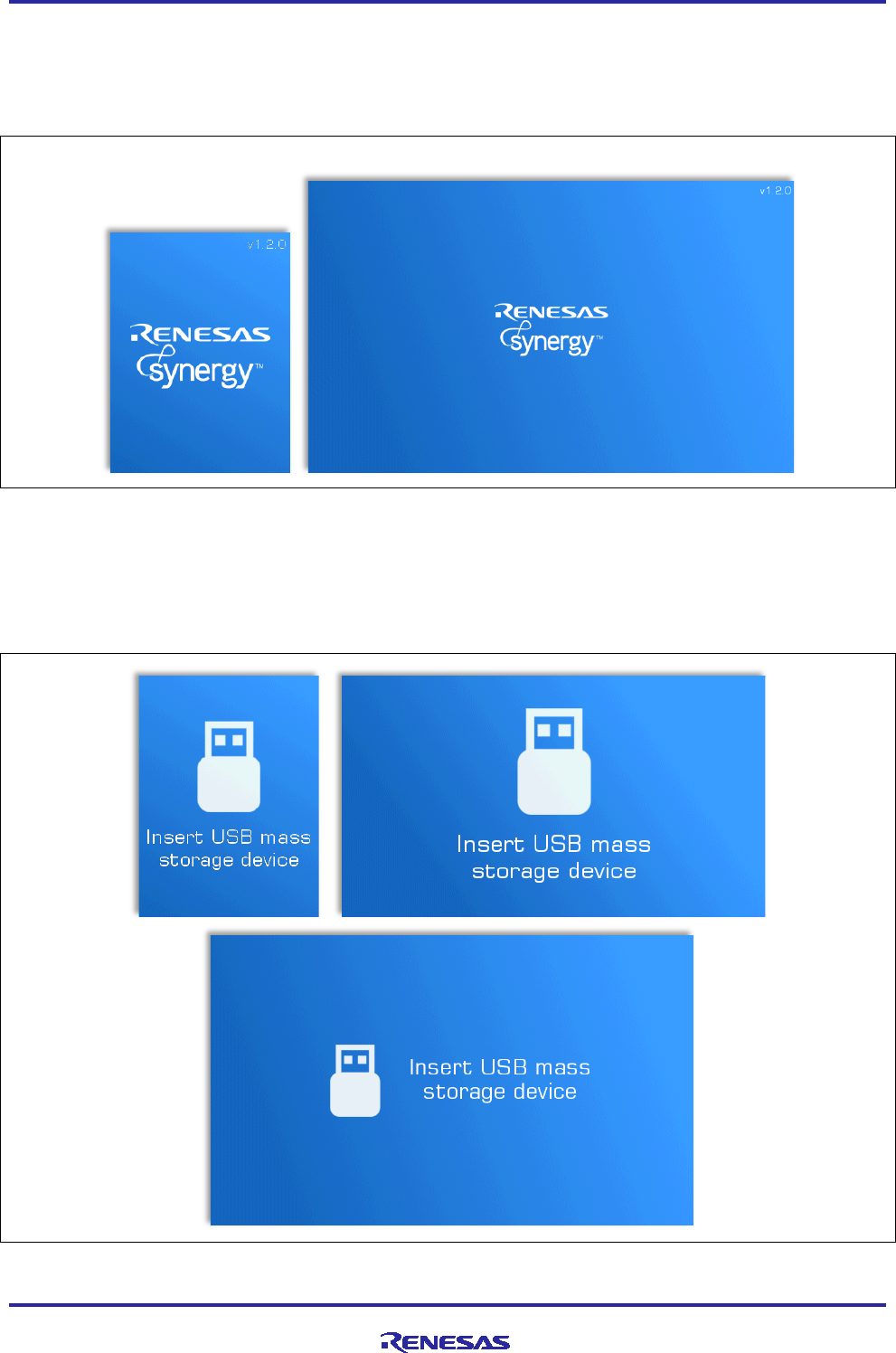
Renesas Synergy™ Platform Getting Started with the Audio Player Application using SSP
R30AN0248EU0103 Rev.1.03 Page 4 of 15
May.17.19
3. Application Features
3.1 Splash Screen
You will see the GUIX-rendered splash screen just after you start the program. After several seconds, the
screen changes to the next screen (determined by presence of the USB mass storage device).
Figure 1. Splash Screen (for PK-S5D9/SK-S7, DK-S7/PE-HMI1)
3.2 USB Screen
The USB screen is displayed when the USB mass storage device is not detected. Certain devices are
recognized fast enough for the application to skip this screen and jump straight to the main screen. Others
will require additional time to fully initialize before being recognized by the Synergy board. It will also be
displayed when no mass storage devices are plugged in.
Figure 2. USB Screen (top-left: SK-S7/PK-S5D9, top-right: DK-S7, bottom: PE-HMI1)
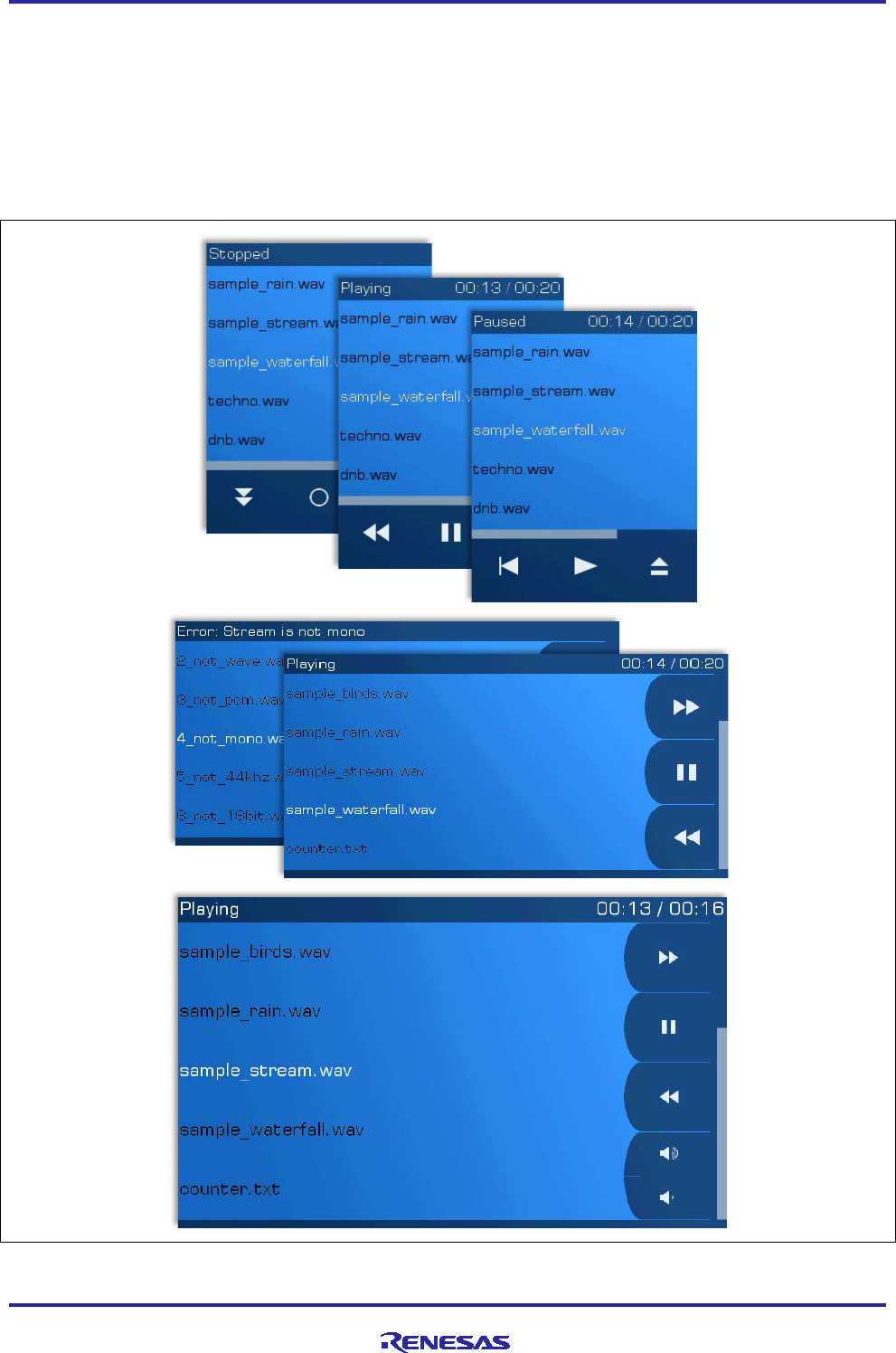
Renesas Synergy™ Platform Getting Started with the Audio Player Application using SSP
R30AN0248EU0103 Rev.1.03 Page 5 of 15
May.17.19
3.3 Main Screen
3.3.1 Overview
The main audio player screen appears once a USB mass storage device has been detected. This window
consists of the status bar, file browser, and three buttons (five buttons on PE-HMI1). The interface
dynamically adjusts to reflect the current playback status and provide necessary functionality. The file
browser allows the user to explore the file system and open PCM WAVE files for playback.
All screen contents are rendered by D/AVE2D drawing engine and are displayed on the TFT screen
connected to the Graphic LCD Controller.
Figure 3. Main Screen (from the top: SK-S7/PK-S5D9, DK-S7, and PE-HMI1)
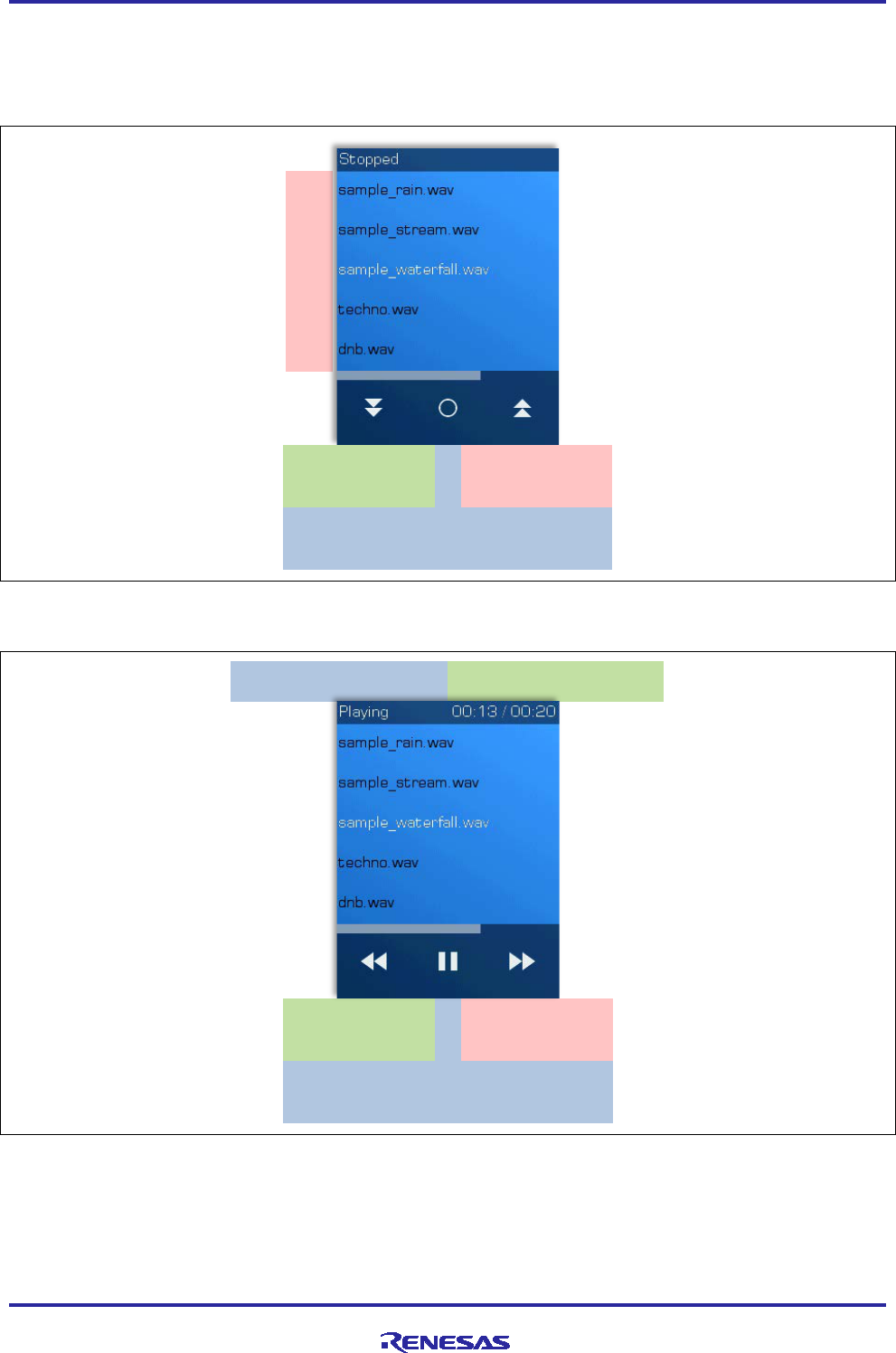
Renesas Synergy™ Platform Getting Started with the Audio Player Application using SSP
R30AN0248EU0103 Rev.1.03 Page 6 of 15
May.17.19
3.3.2 Playback Controls
The Graphical User Interface (GUI) behaves differently for each playback status. This allows screen space to
be re-used in order to provide complete audio player functionality.
Figure 4. Main Screen (1) GUI while playback is stopped
Figure 5. Main Screen (2) GUI when audio is playing
File List
Scroll Down Scroll Up
Open Folder / Play WAV File
Playback Time Playback Status
Rewind 10
seconds
Skip forward 10
seconds
Pause Playback
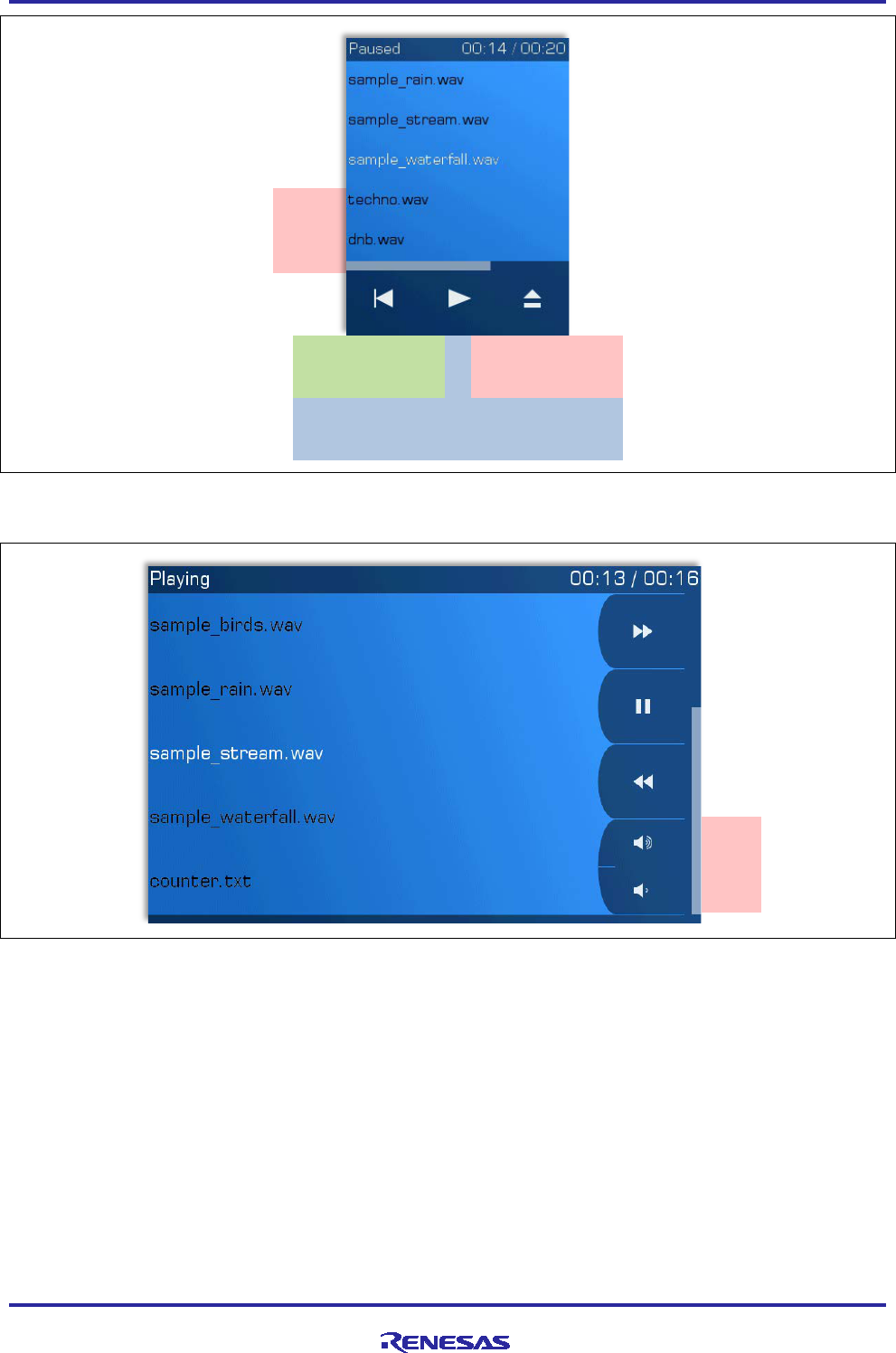
Renesas Synergy™ Platform Getting Started with the Audio Player Application using SSP
R30AN0248EU0103 Rev.1.03 Page 7 of 15
May.17.19
Figure 6. Main Screen (3) GUI when playback is paused
Figure 7. Main Screen on PE-HMI1 with on-screen volume controls
Due to limited screen space, the application utilizes two on-board pushbuttons (S5 and S4 on SK-S7/PK-
S5D9 and S2 and S3 on DK-S7) for playback volume control (down and up, respectively). PE-HMI1 version
of the application implements on-screen volume controls due to lack of on-board pushbuttons.
3.4 Compatible Audio Formats
The audio player application will stop any playback and take the user back to the USB Screen if the USB
device is removed. RIFF header recognition allows the program to prevent playback of incompatible WAV
files. In order to play music on your Renesas Synergy S7G2 board, make sure the USB mass storage device
is formatted to FAT16/32 and the WAVE audio files are uncompressed (PCM), signed, 16-bit per sample,
mono, 44.1-kHz streams. Status bar will display an error message once incompatible file attempts playback.
Compatible audio files can be created from most input formats using the ffmpeg codec with the following
command:
ffmpeg -i %infile% -acodec pcm_s16le -ac 1 -ar 44100 %outfile%
Volume
Indicator
Restart Track
Stop / Exit
Playback
Resume Playback
Volume
Control

Renesas Synergy™ Platform Getting Started with the Audio Player Application using SSP
R30AN0248EU0103 Rev.1.03 Page 8 of 15
May.17.19
4. Application Design
4.1 Source Code Layout
Code for the Audio Player is split among four thread entry files; the GUIX Event Handler, a custom
application-defined header file, and a payload definition file. This layout creates robust building blocks easily
ported into another application (if the configuration for the thread and its modules is also copied).
User-created source files:
• application_define.h
• application_payloads.h
• audio_thread_entry.c
• gui_thread_entry.c
• touch_thread_entry.c
• usb_thread_entry.c
• sf_audio_dummy_entry.c
• guix_gen/audio_player_events.c
User-generated or referenced source files:
• audio_player_specifications.c/.h
• audio_player_resources.c/.h
• lcd_setup/lcd_setup.c/.h (only on SK-S7/PK-S5D9)
4.2 Thread Layout
4.2.1 Module Hierarchy
Figure 8 illustrates the hierarchy and dependency of the modules belonging to each thread. Conventional
design implements GUI and Touch functionality on the same thread (usually called HMI). The Audio Player
application separates the two to emphasize independency between touch and display peripherals and also
to provide separate subscriber threads for touch and callback messages, both of which are converted and
forwarded to GUIX.
Figure 8. Module Hierarchy

Renesas Synergy™ Platform Getting Started with the Audio Player Application using SSP
R30AN0248EU0103 Rev.1.03 Page 9 of 15
May.17.19
4.2.2 Thread Modules and Objects
In addition to core module blocks visible on the previous diagram, the Audio Player application employs
additional ThreadX objects such as queues and semaphores. These objects enable communication between
threads and control the code execution without blocking the processor.
4.3 Thread Initialization
Even though different functionalities are isolated into separate threads, minimal dependency between each
thread is still present. When launching the application, make sure that modules, objects, and variables that
aren’t yet initialized are not accessed from another thread. Fundamental functionality (Mass Storage Controller
and Audio Thread) must be initialized before proceeding to enable GUI and other HMI features (Touch). Audio
Player using Audio Playback Framework launches its threads in the order shown in Figure 9.
Figure 9. Thread Initialization Order
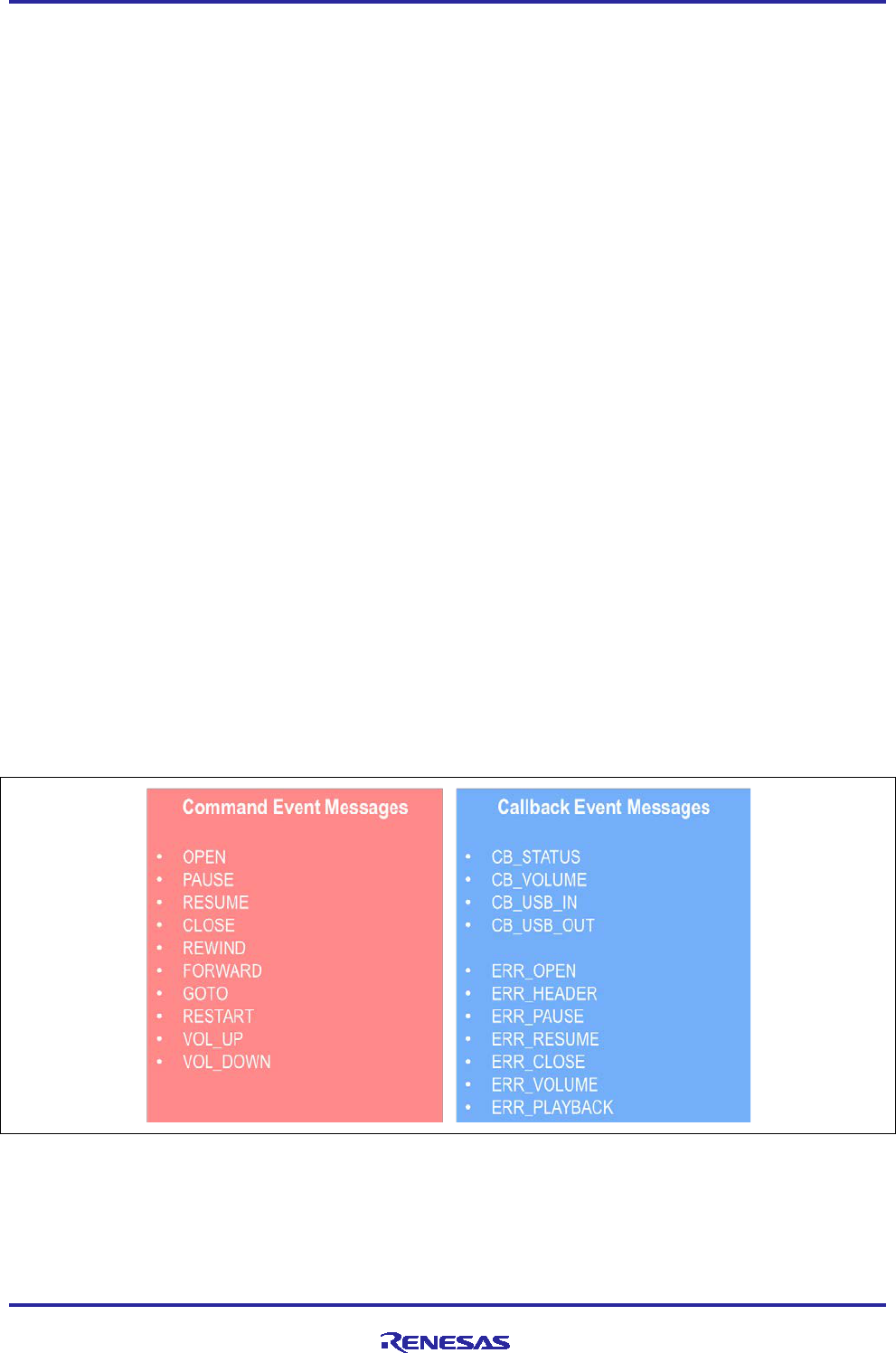
Renesas Synergy™ Platform Getting Started with the Audio Player Application using SSP
R30AN0248EU0103 Rev.1.03 Page 10 of 15
May.17.19
4.4 Thread Resources
4.4.1 Static Variables
• usb_thread_entry.c
Storage instance in *gp_storage
Media pointer in *gp_storage_media
USB host stack in g_usb_memory
• audio_thread_entry.c
2 read buffers in g_file_buffer[2]
Buffered data size in g_acutal_size[2]
Index of accessed buffer in g_current_buffer
• audio_player_events.c
Directory file list in g_file_list
Index of the selected list entry in
g_file_list_index
4.4.2 Global Variables
• Media Storage pointer in *gp_media
Declared in usb_thread_entry scope
Accessed from audio_thread_entry scope
• Audio file RIFF header in g_file_info and audio
player status in g_player_status
Declared in audio_thread_entry scope
Accessed from audio_player_events scope
• Root window pointer in *p_window_root
Declared in gui_thread_entry scope
Accessed from audio_player_events scope
4.5 Inter-thread Communication
The messaging framework is the core module responsible for communication between threads. It provides a
thread-safe way of sharing variables that is built on top of the ThreadX Queue module. It expands the basic
functionality by providing a unified scheme for message format that includes its class, code, and payload.
Since queues are only used to pass a pointer to the message, the actual message size can be greatly
increased to accommodate custom payload structure. The Audio Player application uses four different
message classes:
• SSP-defined: TOUCH and AUDIO
• Application-defined: APP_CMD and APP_CB (application command and callback, respectively)
• Command messages (APP_ prefix):
Posted from GUIX Event Thread and pushbutton interrupt callback function
Received and parsed by Audio Thread
• Callback messages (APP_CB and APP_ERR prefixes):
Posted from Audio and USB Threads
Received by GUI Thread and forwarded to GUIX Event Thread as GX_EVENT
Figure 10. Command and Callback Messages
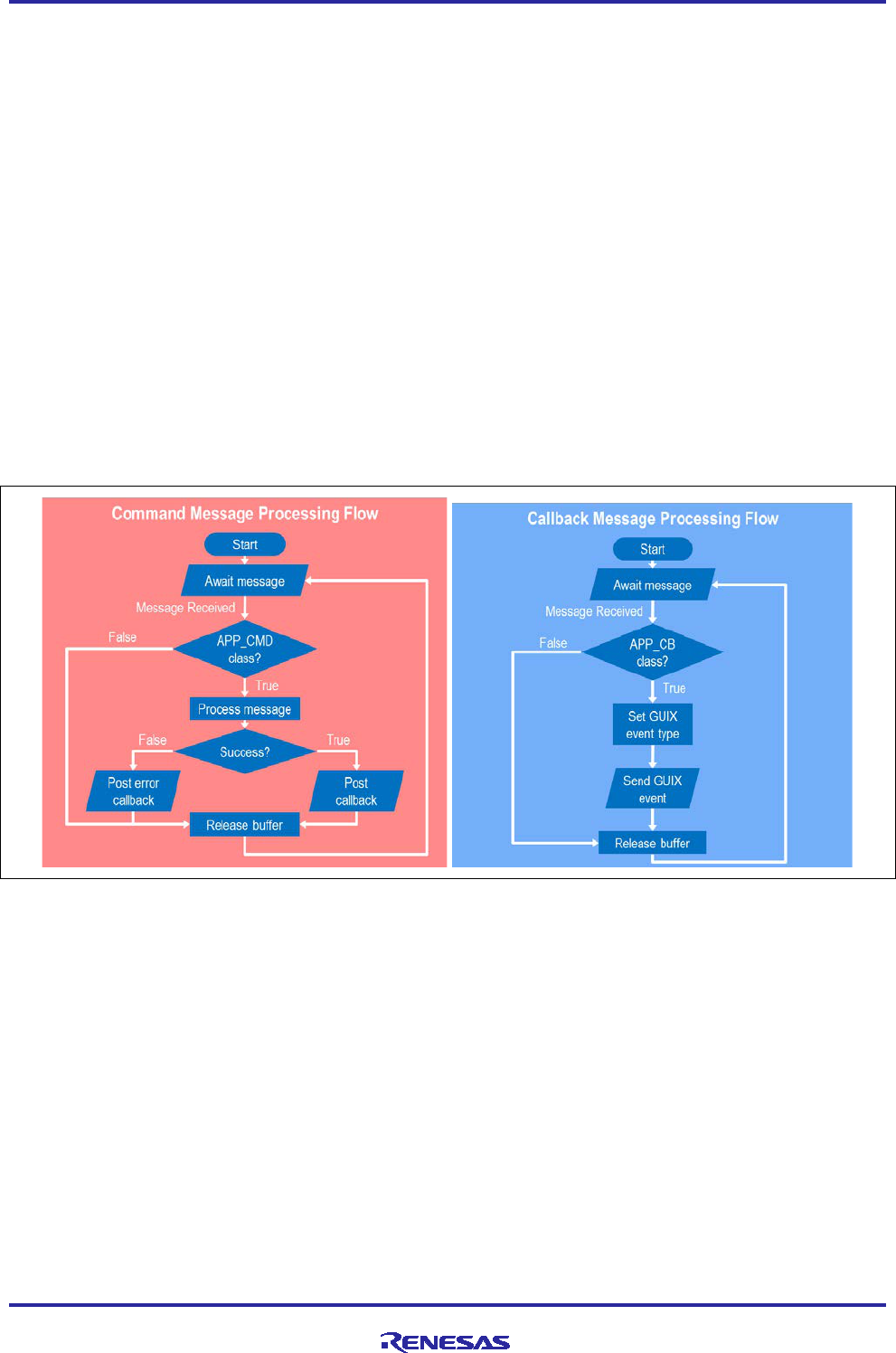
Renesas Synergy™ Platform Getting Started with the Audio Player Application using SSP
R30AN0248EU0103 Rev.1.03 Page 11 of 15
May.17.19
4.5.1 Command Messages
All command messages in the Audio Player application are processed by the Audio Thread. They lead to a
sequence of FileX and SF_MESSAGE API calls in order to control playback and dataflow into the internal
Audio Framework Thread. The messages can be sent from any thread, allowing the user to replace the GUI
with a different interface while retaining full audio playback control capabilities as the underlying USB and
Audio Threads are not affected.
Most commands use a payload structure to provide additional data such as the name of the file to be opened
or the step size for volume change. Successful execution of the command generates a callback message,
which is fed back into the GUIX Event Thread to update status of the interface or display an on-screen
message.
4.5.2 Callback Messages
Audio Thread also posts callback messages to report completion of the task (or an error, if encountered). As
the majority of the commands are posted from the GUIX Event Thread, the callback messages are routed
into the GUIX Event Thread for the GUI to reflect the Audio Thread status (by adjusting the interface and
displaying messages).
Every status change generates a callback message. Therefore, the GUI does not have to check global
variables regularly. Instead, it only needs to acquire status upon receiving a message. All callback messages
are interpreted into GX_EVENTs so that they are handled within the window event process, along with other
GUI events such as touchscreen input. When an error callback is posted, the message payload carries a
return value from the function that failed to execute.
Figure 11. Message Flow
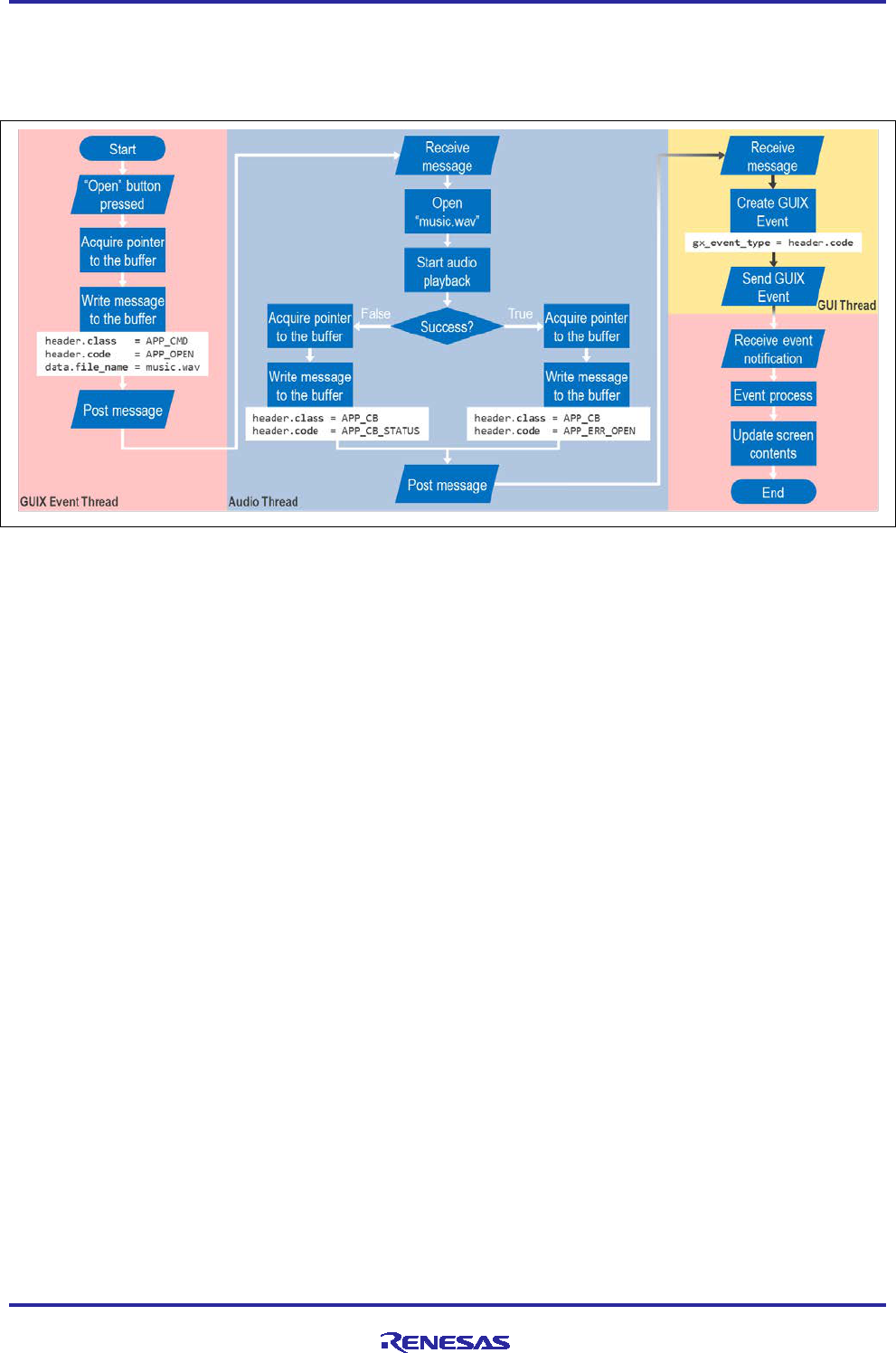
Renesas Synergy™ Platform Getting Started with the Audio Player Application using SSP
R30AN0248EU0103 Rev.1.03 Page 12 of 15
May.17.19
4.6 Message Process Flow Example
Figure 12 is an example of the steps taken to process an “open” command and generate callback upon
successful completion of the task. Please note that the flowchart is simplified and focuses on illustrating
message flow between the threads rather than step-by-step execution sequence.
Figure 12. Message Processing Example
For more detail on audio thread processing, please see the section 4.7.
4.7 Audio Thread Processing Flow
Audio Thread implements the Audio Playback Framework, creating the foundation of this application. It is
fully controlled using the messaging framework. Since messages can be sent and received by any thread,
the graphical user interface (GUI) of this application can easily be replaced with an alternative input/output
media such as USB CDC AMC device (using USBX), telnet console, or a remote website (both using NetX).
Ping-pong buffering is used to preload audio data while maintaining seamless playback and GUI
responsiveness. Buffer size is set to 8 KB, which is enough to store about 90 ms of the 16-bit PCM mono
stream.
The thread runs in a permanent loop, first awaiting message for a single ThreadX tick (default value: 10 ms)
before generating timeout and resuming with playback processing. Here, player status is verified (to be
PLAYING) before the thread attempts to push another set of samples into the buffer. A counting semaphore
determines whether the contents of the buffer have been played. When playback is PAUSED or STOPPED,
or semaphore count is zero, the thread hands off processor control to other threads before restarting the loop
to await another message.
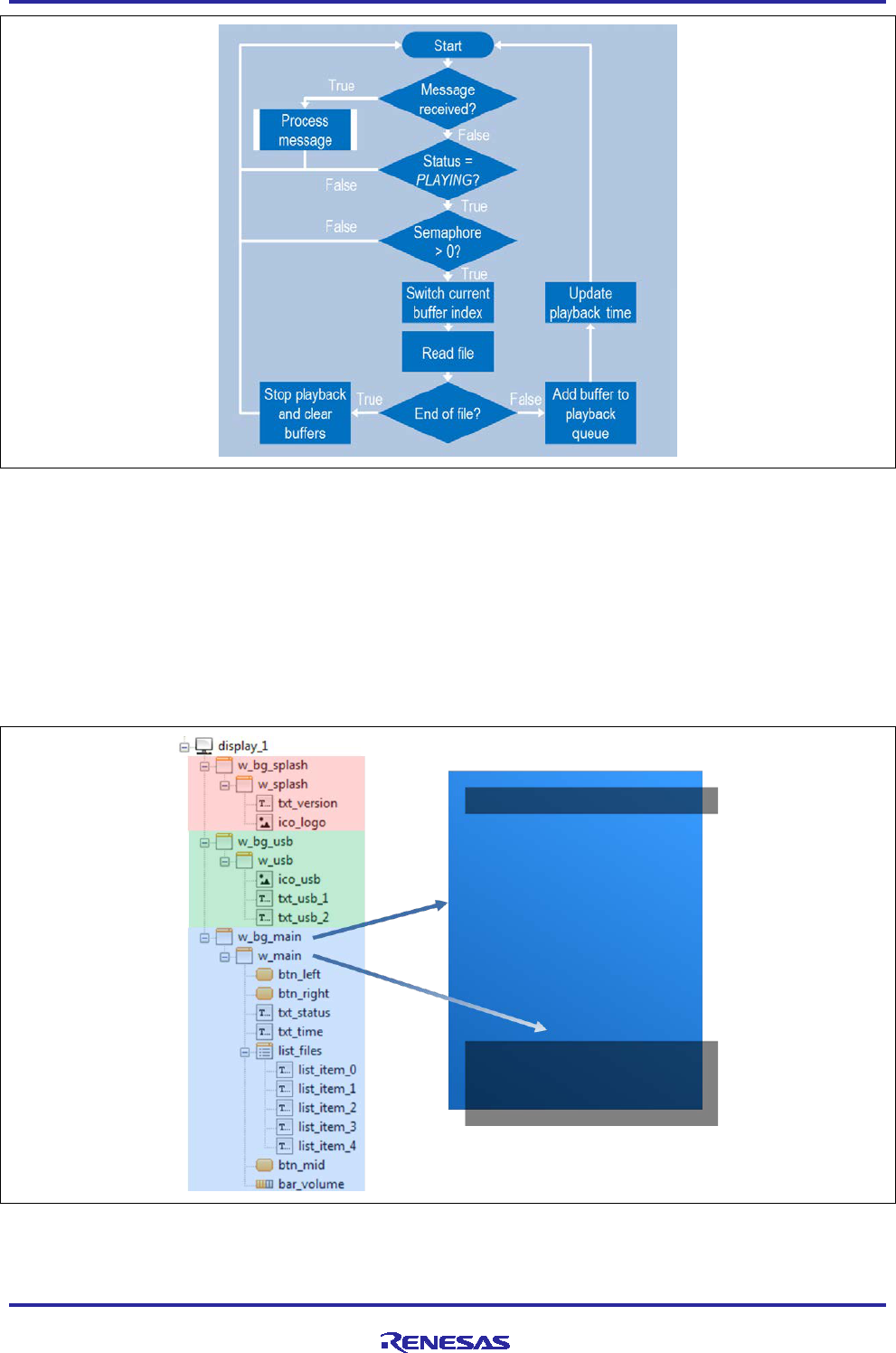
Renesas Synergy™ Platform Getting Started with the Audio Player Application using SSP
R30AN0248EU0103 Rev.1.03 Page 13 of 15
May.17.19
Figure 13. Audio Thread Processing Flow
4.8 GUI Structure
The graphical user interface (GUI) is the primary input and output media for this application. The GUI is split
into three screens: splash, USB, and main. Content windows are embedded into, and displayed over, their
background parent window, as shown in the following graphic, to allow independent control of the
background and overlay pixel maps. Events for all widgets (such as buttons and text labels) are handled by
the event process of their parent window.
Audio Player application uses 16 alpha-enabled pixel maps and two 8-bit fonts to provide a smooth GUI
experience. These resources add up to just under 440 kB, leaving plenty of room in flash memory for
alternative themes and additional features.
Figure 14. GUI Structure

Renesas Synergy™ Platform Getting Started with the Audio Player Application using SSP
R30AN0248EU0103 Rev.1.03 Page 14 of 15
May.17.19
Website and Support
Visit the following vanity URLs to learn about key elements of the Synergy Platform, download components
and related documentation, and get support.
Synergy Software www.renesas.com/synergy/software
Synergy Software Package www.renesas.com/synergy/ssp
Software add-ons www.renesas.com/synergy/addons
Software glossary www.renesas.com/synergy/softwareglossary
Development tools www.renesas.com/synergy/tools
Synergy Hardware www.renesas.com/synergy/hardware
Microcontrollers www.renesas.com/synergy/mcus
MCU glossary www.renesas.com/synergy/mcuglossary
Parametric search www.renesas.com/synergy/parametric
Kits www.renesas.com/synergy/kits
Synergy Solutions Gallery www.renesas.com/synergy/solutionsgallery
Partner projects www.renesas.com/synergy/partnerprojects
Application projects www.renesas.com/synergy/applicationprojects
Self-service support resources:
Documentation www.renesas.com/synergy/docs
Knowledgebase www.renesas.com/synergy/knowledgebase
Forums www.renesas.com/synergy/forum
Training www.renesas.com/synergy/training
Videos www.renesas.com/synergy/videos
Chat and web ticket www.renesas.com/synergy/resourcelibrary
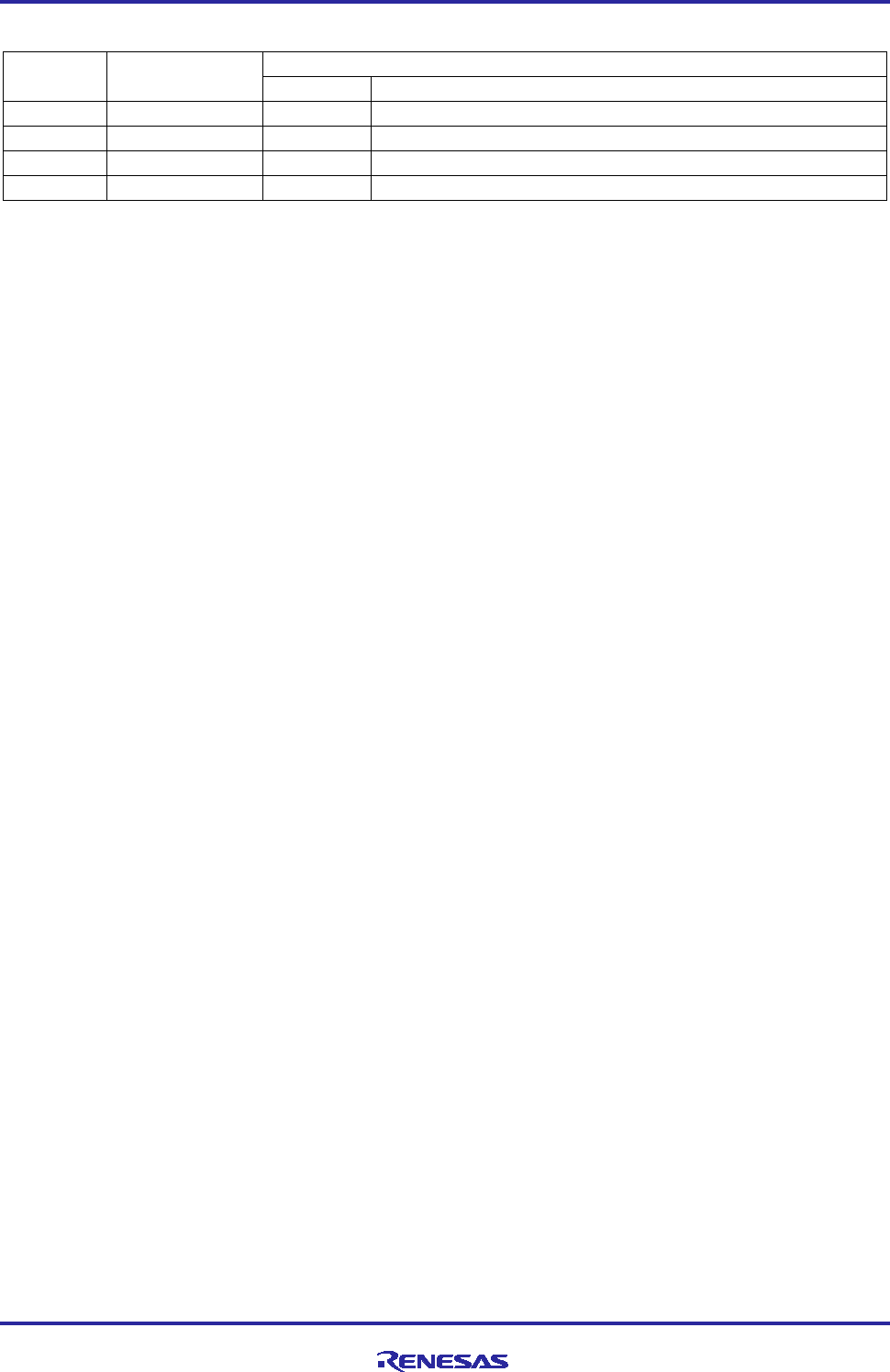
Renesas Synergy™ Platform Getting Started with the Audio Player Application using SSP
R30AN0248EU0103 Rev.1.03 Page 15 of 15
May.17.19
Revision History
Rev.
Date
Description
Page
Summary
1.00
Jun.21.16
-
Initial version.
1.01
Nov.18.16
-
Minor formatting changes.
1.02
Oct.11.18
-
Support for SSP v1.5.0
1.03
May.17.19
-
Updates for SSP v1.6.0

© 2019 Renesas Electronics Corporation. All rights reserved.
Notice
1. Descriptions of circuits, software and other related information in this document are provided only to illustrate the operation of semiconductor products
and application examples. You are fully responsible for the incorporation or any other use of the circuits, software, and information in the design of your
product or system. Renesas Electronics disclaims any and all liability for any losses and damages incurred by you or third parties arising from the use
of these circuits, software, or information.
2. Renesas Electronics hereby expressly disclaims any warranties against and liability for infringement or any other claims involving patents, copyrights,
or other intellectual property rights of third parties, by or arising from the use of Renesas Electronics products or technical information described in this
document, including but not limited to, the product data, drawings, charts, programs, algorithms, and application examples.
3. No license, express, implied or otherwise, is granted hereby under any patents, copyrights or other intellectual property rights of Renesas Electronics
or others.
4. You shall not alter, modify, copy, or reverse engineer any Renesas Electronics product, whether in whole or in part. Renesas Electronics disclaims any
and all liability for any losses or damages incurred by you or third parties arising from such alteration, modification, copying or reverse engineering.
5. Renesas Electronics products are classified according to the following two quality grades: “Standard” and “High Quality”. The intended applications for
each Renesas Electronics product depends on the product’s quality grade, as indicated below.
"Standard": Computers; office equipment; communications equipment; test and measurement equipment; audio and visual equipment; home
electronic appliances; machine tools; personal electronic equipment; industrial robots; etc.
"High Quality": Transportation equipment (automobiles, trains, ships, etc.); traffic control (traffic lights); large-scale communication equipment; key
financial terminal systems; safety control equipment; etc.
Unless expressly designated as a high reliability product or a product for harsh environments in a Renesas Electronics data sheet or other Renesas
Electronics document, Renesas Electronics products are not intended or authorized for use in products or systems that may pose a direct threat to
human life or bodily injury (artificial life support devices or systems; surgical implantations; etc.), or may cause serious property damage (space
system; undersea repeaters; nuclear power control systems; aircraft control systems; key plant systems; military equipment; etc.). Renesas Electronics
disclaims any and all liability for any damages or losses incurred by you or any third parties arising from the use of any Renesas Electronics product
that is inconsistent with any Renesas Electronics data sheet, user’s manual or other Renesas Electronics document.
6. When using Renesas Electronics products, refer to the latest product information (data sheets, user’s manuals, application notes, “General Notes for
Handling and Using Semiconductor Devices” in the reliability handbook, etc.), and ensure that usage conditions are within the ranges specified by
Renesas Electronics with respect to maximum ratings, operating power supply voltage range, heat dissipation characteristics, installation, etc. Renesas
Electronics disclaims any and all liability for any malfunctions, failure or accident arising out of the use of Renesas Electronics products outside of such
specified ranges.
7. Although Renesas Electronics endeavors to improve the quality and reliability of Renesas Electronics products, semiconductor products have specific
characteristics, such as the occurrence of failure at a certain rate and malfunctions under certain use conditions. Unless designated as a high reliability
product or a product for harsh environments in a Renesas Electronics data sheet or other Renesas Electronics document, Renesas Electronics
products are not subject to radiation resistance design. You are responsible for implementing safety measures to guard against the possibility of bodily
injury, injury or damage caused by fire, and/or danger to the public in the event of a failure or malfunction of Renesas Electronics products, such as
safety design for hardware and software, including but not limited to redundancy, fire control and malfunction prevention, appropriate treatment for
aging degradation or any other appropriate measures. Because the evaluation of microcomputer software alone is very difficult and impractical, you are
responsible for evaluating the safety of the final products or systems manufactured by you.
8. Please contact a Renesas Electronics sales office for details as to environmental matters such as the environmental compatibility of each Renesas
Electronics product. You are responsible for carefully and sufficiently investigating applicable laws and regulations that regulate the inclusion or use of
controlled substances, including without limitation, the EU RoHS Directive, and using Renesas Electronics products in compliance with all these
applicable laws and regulations. Renesas Electronics disclaims any and all liability for damages or losses occurring as a result of your noncompliance
with applicable laws and regulations.
9. Renesas Electronics products and technologies shall not be used for or incorporated into any products or systems whose manufacture, use, or sale is
prohibited under any applicable domestic or foreign laws or regulations. You shall comply with any applicable export control laws and regulations
promulgated and administered by the governments of any countries asserting jurisdiction over the parties or transactions.
10. It is the responsibility of the buyer or distributor of Renesas Electronics products, or any other party who distributes, disposes of, or otherwise sells or
transfers the product to a third party, to notify such third party in advance of the contents and conditions set forth in this document.
11. This document shall not be reprinted, reproduced or duplicated in any form, in whole or in part, without prior written consent of Renesas Electronics.
12. Please contact a Renesas Electronics sales office if you have any questions regarding the information contained in this document or Renesas
Electronics products.
(Note1) “Renesas Electronics” as used in this document means Renesas Electronics Corporation and also includes its directly or indirectly controlled
subsidiaries.
(Note2) “Renesas Electronics product(s)” means any product developed or manufactured by or for Renesas Electronics.
(Rev.4.0-1 November 2017)
Corporate Headquarters
Contact information
TOYOSU FORESIA, 3-2-24 Toyosu,
Koto-ku, Tokyo 135-0061, Japan
www.renesas.com
For further information on a product, technology, the most up-to-date
version of a document, or your nearest sales office, please visit:
www.renesas.com/contact/
.
Trademarks
Renesas and the Renesas logo are trademarks of Renesas Electronics
Corporation. All trademarks and registered trademarks are the property
of their respective owners.
